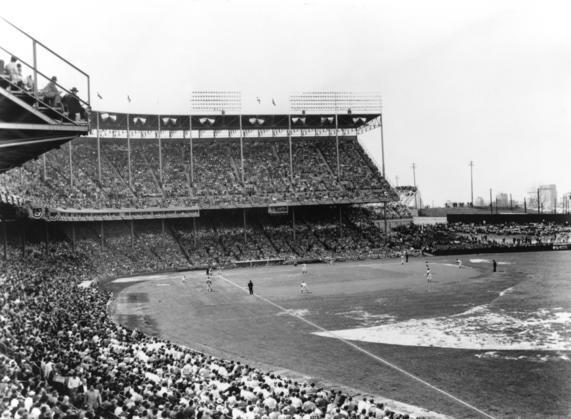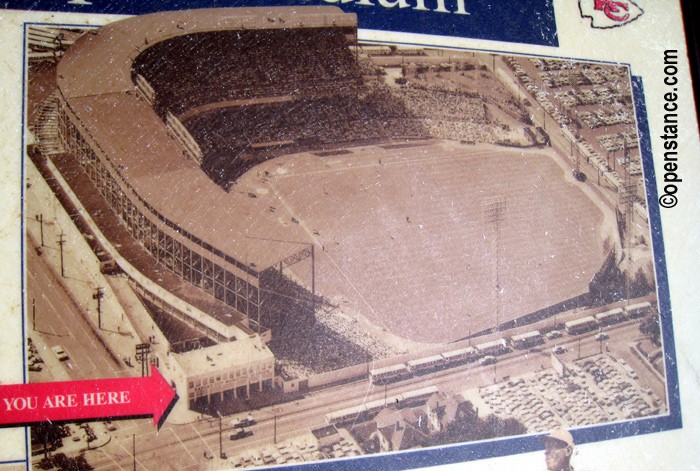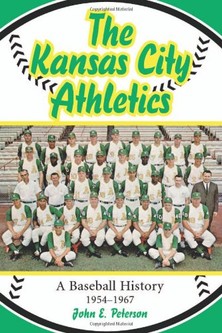Municipal Stadium (Muehlebach Field)
Introduction
Text-to-speech Audio
Kansas City's Muehlebach Field was built at this location in 1923 at a cost of $400,000 to the George Muehlebach Brewing Company. The stadium was built for the Kansas City Blues of Major League Baseball's American Association. The ballpark was also home to the Kansas City Monarchs, the longest-operating and arguably the most successful franchise in Negro League history. From 1923 to 1955, the stadium housed the Monarchs and also featured four Colored World Series. In addition, the stadium was home to three NFL teams throughout its history. The stadium changed its name to Municipal Stadium in 1955 when it became home to the Kansas City Athletics, a team that was part of Major League Baseball's American League between 1955 and 1967. The Athletics left Kansas City for Oakland in 1968 but Municipal Stadium once again hosted Major League baseball when Kansas City and Seattle secured expansion teams in 1969. The Kansas City Royals called Municipal Stadium home for two years, moving to Royals Stadium (known as Kaufmann Stadium today) in 1971. Municipal Stadium also hosted home games of the Kansas City Chiefs between 1963 and the creation of Arrowhead Stadium in 1971. Today, the ballpark is gone and the area is home to several private residences, but there is a small park known as Monarch Plaze that recognizes the history of the field.
Images
Kansas City Municipal Stadium in 1955

Kansas City Municipal Stadium

John Peterson, The Kansas City Athletics: A Baseball History, 1954-1967- Click the link below for more information about this book

Janet Bruce, The Kansas City Monarchs: Champions of Black Baseball-Click the link below for more information about this book

Backstory and Context
Text-to-speech Audio
In 1869, George Muehlebach bought Main Street Brewery which was at the northwest corner of 18th and Main Street. By 1880, Muehlebach had expanded operations and became the largest brewery in the city. The company invested its profits in developing the stadium, a hotel, and several other commercial ventures until 1956 when the company was acquired by Schlitz.
In 1923, Muehlebach Field was built to be a home for the Kansas City Blues, a minor league American Association team. The stadium was known as Muehlebach Field from 1923 to 1937, then Ruppert Stadium from 1938-42, and later Blues Stadium. It was the home for the Kansas City Blues of the American Association and the Kansas City Monarchs, of the Negro Leagues, from 1923-54, and later home to the American League Kansas City A’s from 1955-67 and the K.C. Royals from 1969-1972. The street boundaries were 22nd Street (first base side), Brooklyn Avenue (right field), 21st Street (left field) and Euclid Avenue (third base). The stadium is memorably known for Harvey the Mechanical Rabbit which delighted fans when he rose out of the ground behind home plate to give the umpire fresh baseballs from a basket with bunny ears. The right field embankment once included a small "zoo" to entertain fans of all ages, including grazing sheep, China golden pheasants, Capuchin monkeys, German checker rabbits, peafowl, and other animals.
The stadium was home to the Kansas City Monarchs, the Negro League’s longest-running franchise. Seating was segregated for the Blues games, but the lines of division were removed when the Monarchs played. However, in 1933, the Blues were sold to former Chicago Cubs catcher and Kansas City native Johnny Kling, who encouraged integrated seating for attendees. In 1938, when the park was purchased by Yankee owner Jacob Ruppert, he restituted segregated seating, causing an angry response from the Kansas City Call, one of the City’s Black newspapers.
The ballpark was also the site of the first Colored World Series in 1924 between Hillsdale of the Eastern Colored League and the Kansas City Monarchs, champion of the Negro National League. During its time, Municipal Stadium featured many hall of famers including some of the Negro League’s greatest pitchers, such as Bullet Rogan, José Méndez, and Hilton Smith. During the entire lifespan of the American Association, the only perfect game, which was thrown by Carl de Rose, came in 1947 at Municipal Stadium. In 1955, a major league baseball team, the Philadelphia Athletics, came to the field as well. Their arrival led to renovations that raised rent prices, which then forced the Kansas City Monarchs to leave the stadium after the 1955 season.
1960 was a big year for Municipal Stadium as it hosted both the Major League Baseball All-Star Game and the final Negro Leagues East-West Game. However, the year 1960 was the last big year for Municipal Stadium, though it did remain the home of the Kansas City Athletics until their move to Oakland, California in 1968. Consequently, 1968 became the first year in its history that Municipal Stadium didn’t feature any professional baseball games. After that, it was the home of the Kansas City Royals from 1969-1972. Following the 1972 season, the Royals moved to a new stadium, and Municipal Stadium became empty. Today, part of it is used as a community garden, and part sits as an empty lot.
Select Stadium Highlights
Some highlights include being the site of games #5, #6 and #7 of the first Colored World Series between the Monarchs and the Hilldale Club from Pennsylvania. In 1946, the Monarchs played the Newark Eagles in World Series games #3 and #4 at Blues Stadium, splitting the wins. The largest crowd on record was 36,623 on 3 August 1971 when the Royals played the Oakland Athletics, enroute to 101 wins. The A’s featured many former Kansas City players such as Sal Bando, Rick Monday, Reggie Jackson, Vida Blue, Catfish Hunter and Johnny “Blue Moon” Odom.
Before 30,619 fans, the 28th annual Major League All-Star game was the first All-Star game to be played in Kansas City. It occurred on Monday 11 July 1960 and featured 18 future members of the Hall of Fame. The game was the last All-Star game for Ted Williams and the first for Roberto Clemente and Brooks Robinson. Two Negro League no-hitters were pitched at the ballpark, the first a combination no-hitter thrown by Hall of Fame pitchers José Méndez and Bullet Rogan in 1923 and the second by another Hall of Famer, Hilton Smith, in 1937. In each game, a perfect game was missed because of a single base on balls.
It was also the site of the only nine-inning perfect game ever pitched in the American Association on June 26 1947 by Carl De Rose. The right field embankment featured the image of a German shorthaired pointer dog named Old Drum, a once-legendary dog that has been memorialized with a monument in Warrensburg. Also add “Charlie O. the Mule” to the mix. Also, the short-lived Pennant Porch in 1965, offering a fence 296 feet from home plate to mimic Yankee Stadium’s right field distance. Commissioner Ford Frick vetoed the wooden structure, before the start of the season. This field also saw the final pitching game of Satchel Paige who at the age of 59 pitched while wearing a major league uniform on September 25, 1965 against the Boston Red Sox. Paige pitched three innings, giving up one hit, striking out one batter and yielding no runs.
Cite This Entry
Trowbridge, David J. et. al. "Municipal Stadium (Muehlebach Field)." Clio: Your Guide to History. August 18, 2023. Accessed March 21, 2025. https://theclio.com/tour/605/6/reverse
Sources
"Municipal Stadium (Kansas City)." BaseballReference.com. Accessed July 1, 2014. http://www.baseball-reference.com/bullpen/Municipal_Stadium_(Kansas_City)
"Kansas City Municipal Stadium." Stadiums of Pro Football. Accessed July 1, 2014. http://www.stadiumsofprofootball.com/past/KCMunicipal.htm
Hecken, Phil. "There Used To Be A Ballpark Here." Uni Watch. August 25, 2010. http://www.uni-watch.com/2010/08/25/there-used-to-be-a-ballpark-here-part-i/

